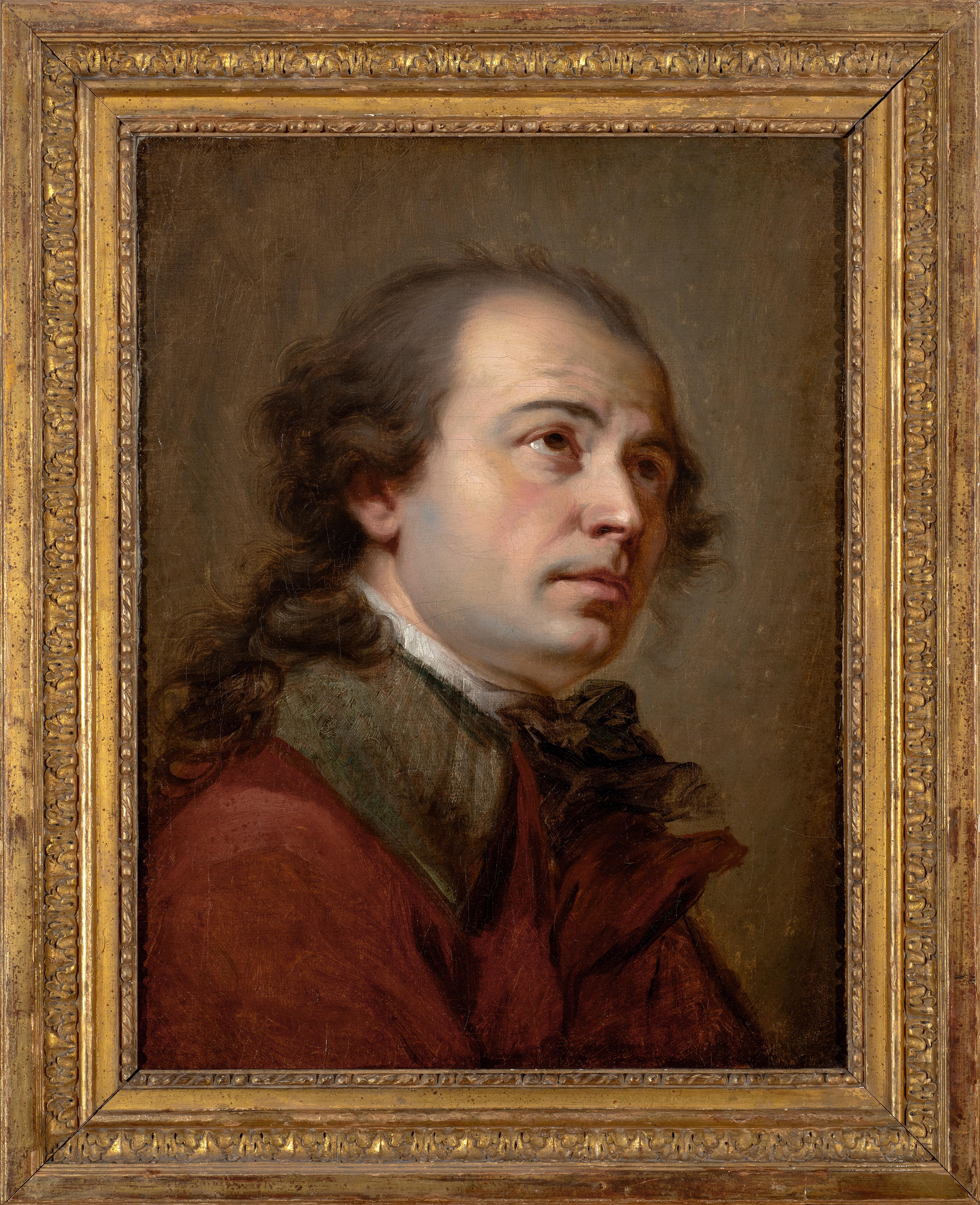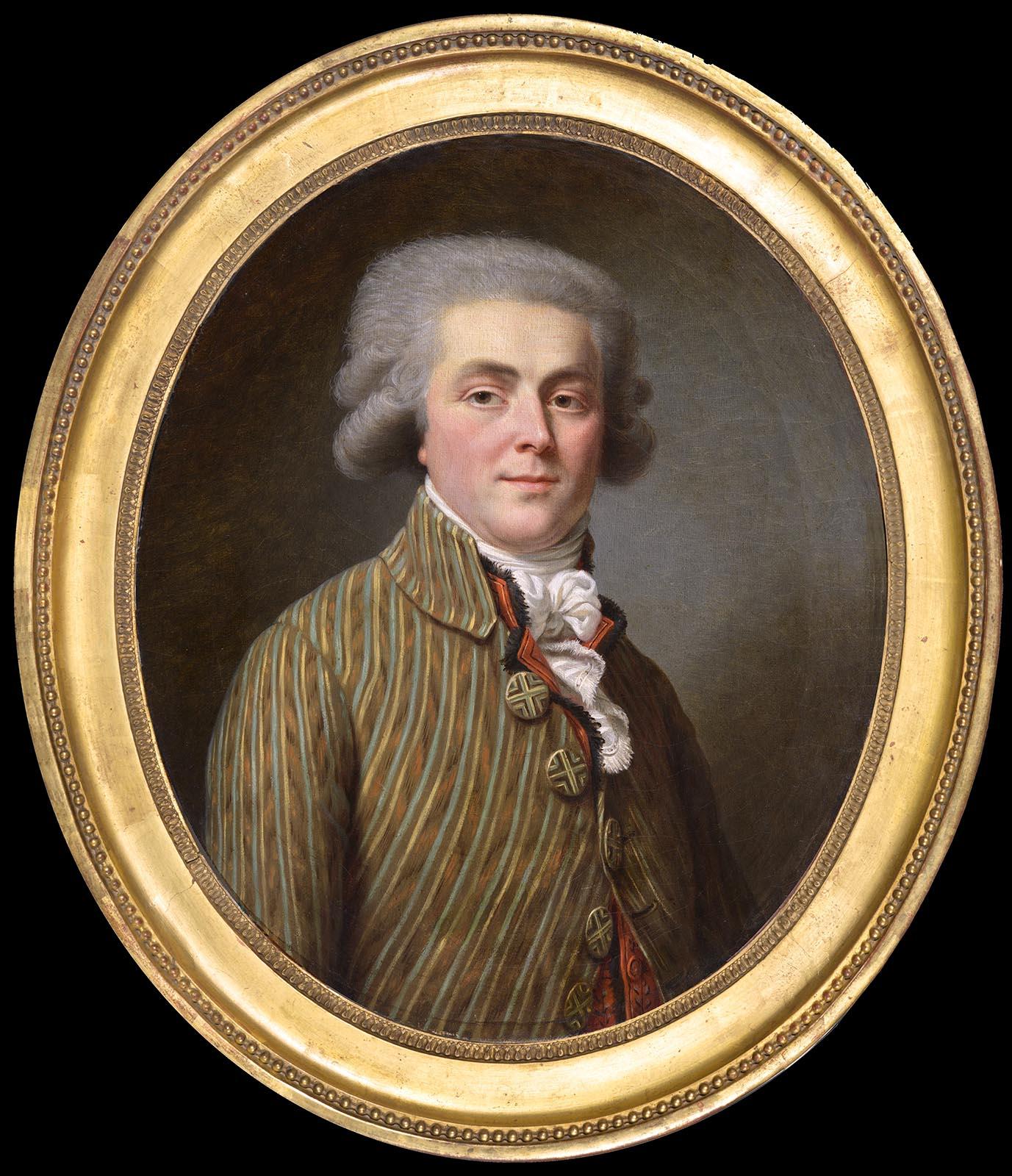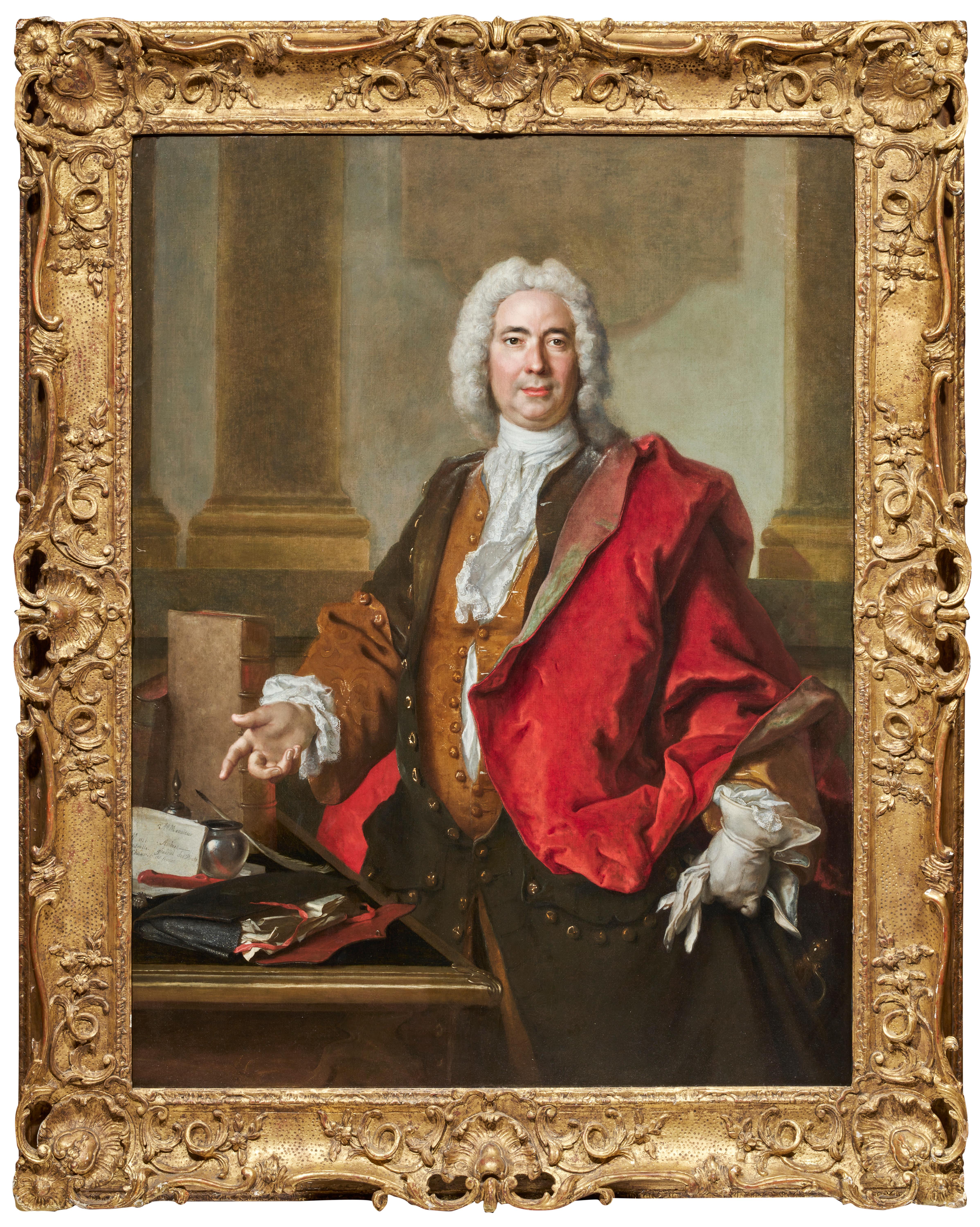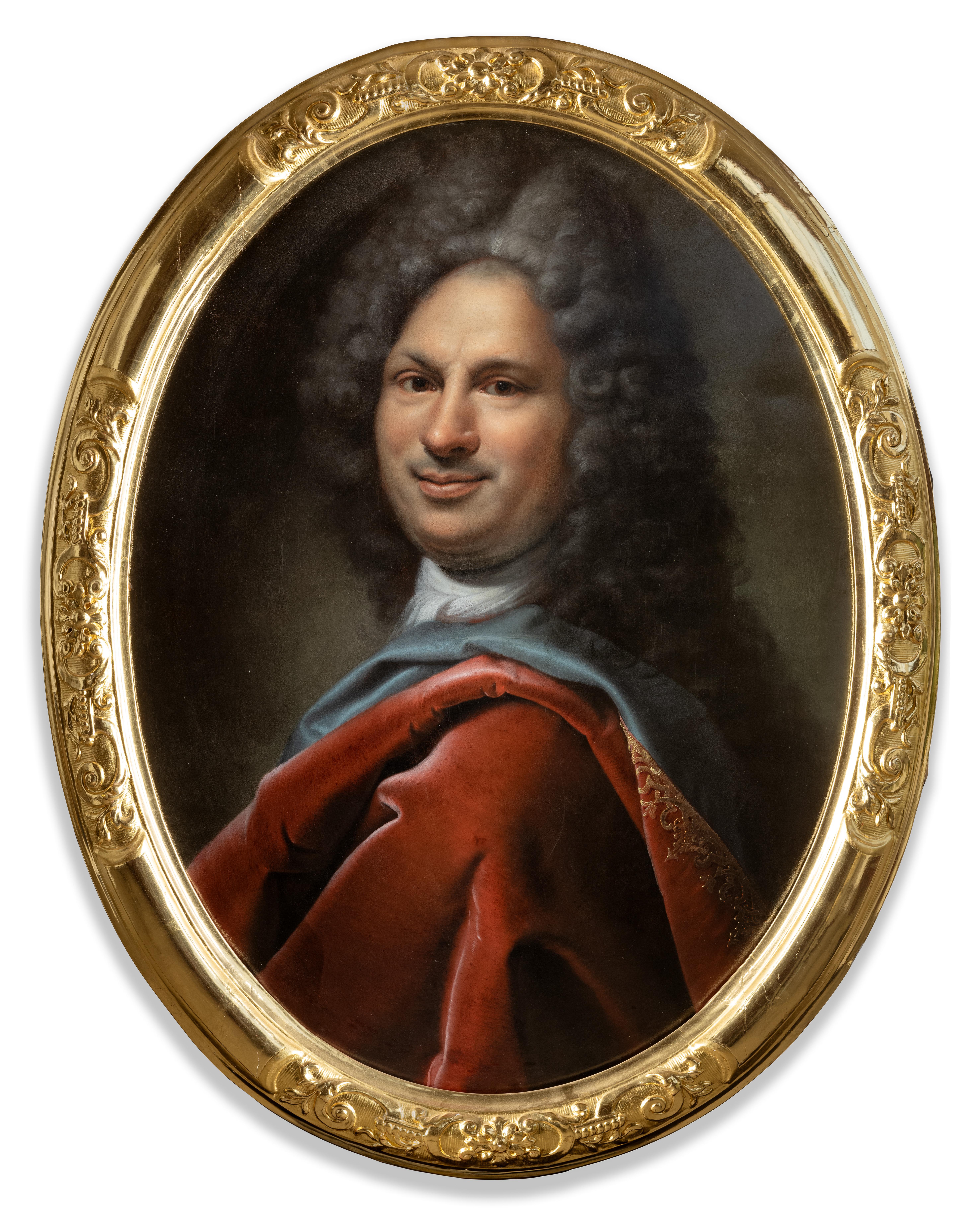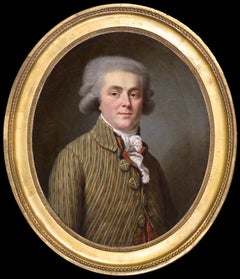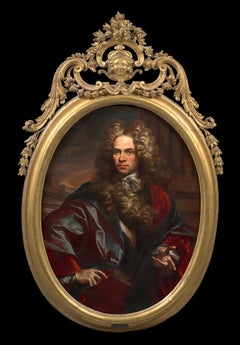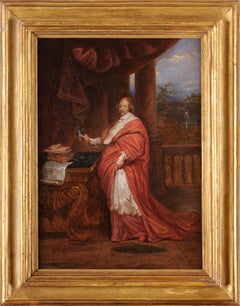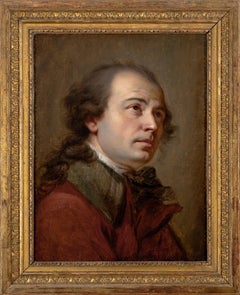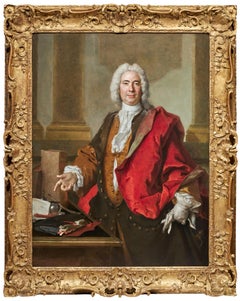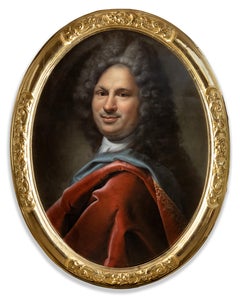Items Similar to Presumed artist self-portrait
Want more images or videos?
Request additional images or videos from the seller
1 of 10
Louis-Gabriel BlanchetPresumed artist self-portraitCirca 1730
Circa 1730
$53,636.47
£39,716.04
€45,000
CA$73,758.19
A$82,026.25
CHF 42,936.96
MX$1,000,620.55
NOK 539,518.53
SEK 507,486.83
DKK 342,613.69
About the Item
Louis-Gabriel BLANCHET
(Versailles, 1701 – Rome, 1772)
Presumed self-portrait of the artist
Oil on canvas
H. 73 cm; W. 60 cm
Circa 1730
Originally presented in a Restoration period frame with a "Mignard" cartouche, this beautiful painting initially appeared to us as a work from northern Italy. However, it exuded a rather French form of refinement, suggesting that its artist may have assimilated a dual influence from both sides of the Alps.
We thank our colleague and friend Philippe Mendès for spontaneously and judiciously "bringing out" the name of Louis-Gabriel Blanchet, a Romanized French portraitist, whose spirit and stylistic characteristics we clearly recognize here.
Blanchet's "French" years, before his final departure for Rome in 1728, following his winning of the second Grand Prix for painting after Subleyras in 1727, are extremely poorly documented. His father, Gabriel, was valet to Blouin, himself Louis XIV's first valet at the time. According to Thierry Lefrançois, Blanchet was one of the few students of Nicolas Bertin (1667-1736), whose studio he is said to have joined in the early 1720s. At a baptism on March 24, 1724, where he was godfather, he is mentioned as a painter in the picture store of the Duke of Antin, the director of buildings between 1708 and 1736. At this time, he was probably already married to Jeanne Quément, with whom he had a daughter also named Jeanne, who would marry Nicolas Aviet, the son of a valet in the queen's wardrobe, in Versailles in 1738.
When Blanchet arrived in Rome in October 1728, he was accompanied by Subleyras, Trémolières, and Slodtz. He enjoyed the goodwill of Vleughels, the director of the Académie de France, which had been based at the Palazzo Mancini since 1725, even though the latter was not always kind to our resident. From 1732, he was under the protection of the Duke of Saint-Aignan when he took up his post as ambassador to Rome. Along with Slodtz and Subleyras, they formed a trio of friends, joined by Joseph Vernet shortly after his arrival in Rome in 1734. Slodtz and Blanchet, on the occasion of Subleyras's marriage in 1739, were there to attest that their friend was not bound by any marital commitment, and Blanchet was a witness at Vernet's wedding in 1745.
It is most likely from these early years in Rome that our portrait of the artist dates, the expression and turn of his face irresistibly reminiscent of a self-portrait. The still relatively youthful features may correspond to Blanchet's thirty-something years, and the fluffy wig was still fashionable at this time.
The painting fits well with the depiction of a young painter wanting to display both the beginnings of success and a certain simplicity or restraint. A slight smile expresses a form of assurance in this man with a gentle, sincere gaze and a face radiating a keen sense of wit. We find here the air of intimacy present in almost all of Blanchet's portraits, even those from the 1750s and 1760s, as well as an almost complicity with the viewer. The spirit of the painting is quite close to that of the presumed portrait of Bouchardon (painted around 1730) and the portrait of Pannini, painted in 1736, but it possesses a more natural quality, notably thanks to the absence of decorum. Our work exhibits the characteristics of Blanchet's paintings: elegance, luminosity (especially in the whites), vibrant and refined colors (here, the harmony of the garnet of the garment and the slate blue of the background, whose uniformity is tempered by a very sketched landscape and a grove of greenery), light complexions, rather rosy cheekbones, often full lips, and rather tight framing.
According to the Academy's rules, Blanchet's stay should have ended in the spring of 1732, but, for reasons unknown, he remained in the Eternal City until his death, as did his friend Subleyras, with whom he shared accommodation until the late 1730s. The latter regularly called upon him to collaborate on his paintings, such as The Meal at Simon's. Through Saint-Aignan's intervention, Blanchet was employed in the late 1730s by the Stuart princely family, then exiled in Italy. He notably produced copies (now lost) after Liotard of the portraits of Charles Edward and Henry Benedict, the sons of James III Stuart. The latter also commissioned three other portraits (now in the National Portrait Gallery in London), whose more formal character contrasts with the intimate spirit of Blanchet's portraits. Blanchet frequented English painters, such as the landscape painter Richard Wilson, and studied with the Scottish portraitist Katherine Read (1723-1778).
Blanchet was known for being helpful and friendly; but he was fickle and spendthrift, often in debt, which earned him imprisonment in 1752. On this occasion, he had not received Natoire's support, the new director of the Academy, while the previous one, Jean-François de Troy (1679-1752), had been rather kind to him.
In 1755, Blanchet remarried an Italian woman, Annunziata Dies, the daughter of a goldsmith, who brought him a form of financial security and stability.
In the 1750s, Blanchet painted allegorical genre scenes with putti in the Rococo style, amiable and decorative, often intended for doorways; he also produced a few religious paintings. But he remained primarily a portraitist, and while he benefited from the abundant clientele of the Grand Tour, particularly the British, he was in strong competition with Pompeo Batoni (1708-1787), who knew how to depict these "tourists" more lavishly in front of ruins and various monuments, while Blanchet retained his more intimate and psychological approach to portraying his models.
Our painting is therefore one of the few early works known by Blanchet, the most intimate and "simple", before the time of the "official" and formal portraits of the Stuarts and official commissions, then the mature period of the years 1750-1770, when the artist remained faithful to his style but applied mastered and proven recipes. It also allows us, very probably, to know his face.
- Creator:Louis-Gabriel Blanchet (1701 - 1772, French)
- Creation Year:Circa 1730
- Dimensions:Height: 28.75 in (73 cm)Width: 23.63 in (60 cm)
- Medium:
- Movement & Style:
- Period:1730-1739
- Condition:
- Gallery Location:BELEYMAS, FR
- Reference Number:1stDibs: LU1857216040132
About the Seller
3.0
Vetted Professional Seller
Every seller passes strict standards for authenticity and reliability
Established in 2017
1stDibs seller since 2022
5 sales on 1stDibs
- ShippingRetrieving quote...Shipping from: BELEYMAS, France
- Return Policy
Authenticity Guarantee
In the unlikely event there’s an issue with an item’s authenticity, contact us within 1 year for a full refund. DetailsMoney-Back Guarantee
If your item is not as described, is damaged in transit, or does not arrive, contact us within 7 days for a full refund. Details24-Hour Cancellation
You have a 24-hour grace period in which to reconsider your purchase, with no questions asked.Vetted Professional Sellers
Our world-class sellers must adhere to strict standards for service and quality, maintaining the integrity of our listings.Price-Match Guarantee
If you find that a seller listed the same item for a lower price elsewhere, we’ll match it.Trusted Global Delivery
Our best-in-class carrier network provides specialized shipping options worldwide, including custom delivery.More From This Seller
View AllPortrait of a man during French Revolution
Located in BELEYMAS, FR
Antoine VESTIER, attributed to
(Avallon, 1740 - Paris, 1824)
Portrait of a man under the Revolution
Oil on canvas
H. 46 cm; L. 37 cm
Circa 1793-95
This beautiful unsigned portrait i...
Category
1790s French School Figurative Paintings
Materials
Canvas, Oil
Italian men portrait
By Giovanni Maria delle Piane dit Mulinaretto (Genoa 1670 - Monticelli d´Ongina 1745)
Located in BELEYMAS, FR
Giovanni Maria DELLE PIANE, known as IL MULINARETTO
(Genoa, 1660 – Monticelli d'Ongina, 1745)
Portrait of a man
Oil on oval canvas
H. 108 cm; L. 83 cm
Provenance: Nino Ferrari Colle...
Category
1740s Italian School Portrait Paintings
Materials
Canvas, Oil
Portrait of a man in armor
Located in BELEYMAS, FR
Attributed to Jacques DUMONT aka DUMONT LE ROMAIN
(Paris 1701 - 1781)
Presumed portrait of Louis-Joseph de Formanoir (?-1732)
Oil on canvas
H. 91.5 cm; L. 73 cm
Signed on the helmet:...
Category
1750s French School Portrait Paintings
Materials
Canvas, Oil
Cardinal Mazarin portrait
Located in BELEYMAS, FR
French School circa 1645
Portrait of Cardinal Mazarin - Sketch
Oil on canvas
H. 41.5 cm; W. 27 cm
Provenance: Collection of the Reverend Georges Downing Bowles (1789-1863)
Would ...
Category
1640s French School Portrait Paintings
Materials
Canvas, Oil
Portrait of Madame Leblond
Located in BELEYMAS, FR
French school circa 1815
Portrait of Madame Leblond
Oil on canvas
H. 66 cm; W. 55 cm
Named on the back
Comparable to the works of painters such as Louis Hersent, our portrait, unsig...
Category
1810s French School Figurative Paintings
Materials
Canvas, Oil
Presumed portrait of Marie-Anne de Bourbon
By Nicolas de Largillière
Located in BELEYMAS, FR
Nicolas de LARGILLIERRE
(Paris 1656 – 1746)
Portrait of a woman, presumed to be Marie-Anne de Bourbon, Princess of Conti (1666-1739)
Oil on oval canvas
H. 8...
Category
Early 1700s French School Figurative Paintings
Materials
Canvas, Oil
You May Also Like
Tête d’expression portrait study of a gentleman
Located in Maidenhead, GB
French Academic School, 18th century
A tête d’expression study of a gentleman, c. 1780-90
Oil on canvas
46.1 x 35 cm.; (within frame) 57.5 x 46.6. cm.
Provenance:
Private Collectio...
Category
1780s French School Portrait Paintings
Materials
Oil
Portrait of Monsieur Aubert, a ceremonial portrait by Nicolas de Largillière
By Nicolas de Largillière
Located in PARIS, FR
Provenance :
Arnold S. Kirkeby (1901-1962)
Donated by Arnold S. Kirkeby to the Los Angeles County Museum of Art in 1955, where it remained until its sale at Sotheby's, New York on Ja...
Category
1720s Old Masters Portrait Paintings
Materials
Oil
Portrait Johann Theodor Bavaria, Son of Prince Elector, by Joseph Vivien, Rococo
By Joseph Vivien
Located in Greven, DE
Portrait of Johann Theodor of Bavaria (1703-1763)
by Joseph Vivien
Johann Theodor of Bavaria (* September 3, 1703 in Munich; † January 27, 1763 in Lièg...
Category
18th Century Rococo Portrait Paintings
Materials
Canvas, Oil
Self Portrait of Schildbach, Court Painter Schildbach, Gotha, Convex Copper
Located in Greven, DE
Christian Schildbach was a very talented artist with his own style.
Art painter in Plauen, then court painter in Dresden; around 1706 art painter in Vienna, also active in Bamberg (...
Category
18th Century Baroque Portrait Paintings
Materials
Copper
Self-Portrait - Royal Academy Founding Member, 18th Century
By Francis Hayman
Located in London, GB
Francis Hayman RA
1708–1776
Self-Portrait
Oil on oak panel
Image size: 8 x 6¼ inches
Contemporary gilt frame
This newly discovered work is the earliest known self portrait by Francis Hayman, dated to the mid to late 1720’s. The small scale of the portrait gives it a strong sense of intimacy. Whereas clients would often dress themselves in their best clothes for a sitting, Hayman has portrayed himself in informal attire, with his shirt unbuttoned and a wig cap.
Born in 1708 to a respectable Devonshire family, his training began at the tender age of ten under the tutelage of the historical painter Robert Brown, who was probably an uncle. By the 1730’s he is known to have been engaged in painting scenery for the popular theatres on Goodman’s Fields and Drury Lane. He established a studio on St Martin’s Lane, and demonstrated his versatility as one of the most
important painters of his time in portraits, illustration and history painting.
Indeed, he was one of the first English painters deemed to have the skill and proficiency to rival that of the foreign masters, such as Holbein and Kneller, who were brought in by the court to make up for the perceived shortcomings of the native artists. Led by William Hogarth, Hayman and other artists began to create a new movement in the English art world. Thomas Gainsborough was one of his pupils, whom he is said to have introduced to the more lascivious and debauched underbelly of London life.
After mostly making his living as an illustrator, in the 1740’s Hayman was commissioned by the proprietor of the Vauxhall Pleasure Gardens, Jonathan Tyers, to produce a series of four large celebratory canvases depicting British victories from the Seven Years War. His association with Tyers continued, and over the next ten years he produced a number of large decorative paintings...
Category
18th Century Old Masters Portrait Paintings
Materials
Oak, Oil Pastel
PORTRAIT OF A GENTLMEN - French School -Portrait Italian Oil on Canvas Painting
By Eugenio De Blasi
Located in Napoli, IT
Portrait of a Gentlemen - Oval oil on canvas cm.50x40, Italia, 2006 Eugenio De Blasi
Wooden frame available on request
The portrait of Eugenio De Blasi is inspired by one of the many portraits painted by Guillam Francois Colson, a French historian painter, who painted portraits of families...
Category
Early 2000s Old Masters Portrait Paintings
Materials
Canvas, Oil
More Ways To Browse
James A Rome
Used Baptismal
Paintings Of Putti
French Wig
Antique Picture Viewer
French Valet
Beautiful Antique French Wardrobe
A Blanchet
Antique French Style Wardrobe
Antique British Uniforms
Antique English Wardrobe
Benedict Studios
Antique Wardrobe London
Jean Philippe Richard
Antique School Slate
Antique Wardrobe Scotland
Earl Christy
Enoch Seeman
